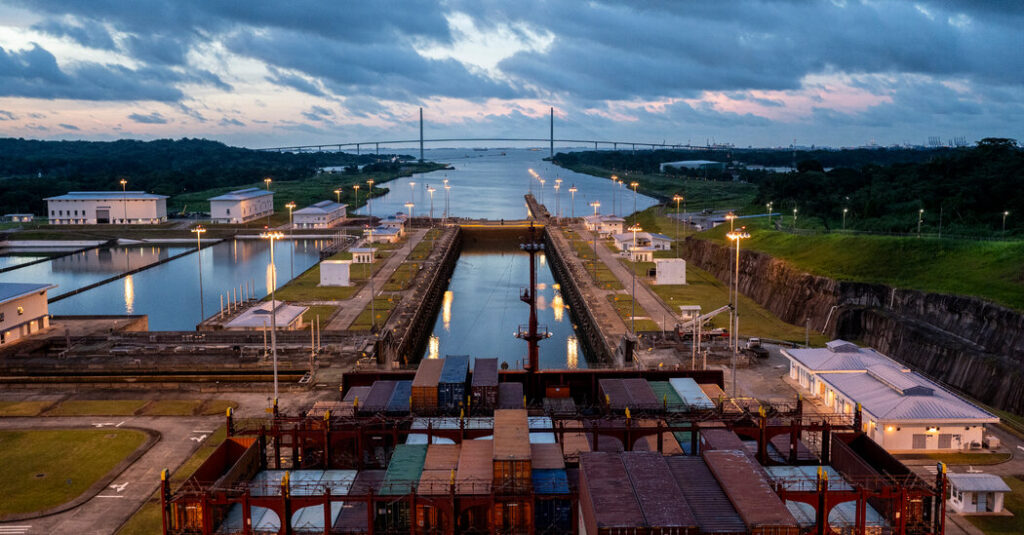Low water ranges have pressured officers to slash the variety of ships which can be allowed via the Panama Canal, disrupting international provide chains and pushing up transportation prices.
But, remarkably, the large drop in ship visitors has not — a minimum of up to now — led to a monetary crunch for the canal, which passes on a lot of its toll income to Panama’s authorities.
That’s as a result of the canal authority launched hefty will increase in tolls earlier than the water disaster began. In addition, transport firms have been prepared to pay giant sums in particular auctions to safe one of many diminished variety of crossings.
In the 12 months via September, the canal’s income rose 15 %, to almost $5 billion, despite the fact that the tonnage shipped via the canal fell 1.5 %.
The Panama Canal Authority declined to say how a lot cash it earned from auctions. At a maritime convention final week in Stamford, Conn., Ilya Espino de Marotta, the canal’s deputy administrator, stated the public sale charges, which reached as a lot as $4 million per passage final yr, “helped a little bit.”
But even now, throughout a quieter season for international transport, public sale charges can double the price of utilizing the canal. This month, Avance Gas, which ships liquefied petroleum fuel, paid a $401,000 public sale charge and $400,000 for the common toll, stated Oystein Kalleklev, the corporate’s chief government. Auction charges are in the end borne by the corporate whose items are being shipped.
The canal’s monetary stability within the face of a dire water scarcity reveals how the individuals who handle essential hyperlinks in international provide chains are adapting as local weather change disrupts operations. It additionally helps that there are not any viable alternate options in Latin America to the canal, an engineering marvel that opened in 1914 and handles an estimated 5 % of seaborne commerce.
If delays proceed and the price retains rising, nonetheless, transport firms might discover methods to keep away from the canal. Last yr, because the canal grew to become backed up, ships that wished to journey from Asia to the East Coast of the United States started going via the Suez Canal, a far longer voyage that makes use of far more gasoline.
Many vessels are nonetheless utilizing a western route from Asia even after the Houthi assaults within the Red Sea pressured transport firms to keep away from the Suez Canal and go round Africa. Mr. Kalleklev stated that, after his vessels had delivered their cargo and had been empty, they now usually returned to the United States by way of the Cape of Good Hope.
Though Panama is without doubt one of the world’s wettest international locations, a pointy drop in rainfall final yr disadvantaged the canal of the water it wants for locks that increase and decrease vessels into and out of the 40-mile passage between the Atlantic and Pacific Oceans. Climate consultants say such water shortages might grow to be extra widespread.
The climate sample often known as El Niño initially causes hotter and drier situations in Panama, and scientists say local weather change could also be prolonging dry spells. Last yr, there was 1.85 meters (six ft) of rainfall within the Panama Canal’s watershed, properly under the historic annual common of two.6 meters, in response to the canal authority. Rainfall within the watershed was under common in six of the final 10 years, together with years that had been the second, third, sixth and seventh driest since 1950, the authority added.
To preserve water, the authority step by step diminished passages from a standard vary of 36 to 38 vessels a day to 22 by December. But higher-than-expected rainfall and the canal’s water dialog measures enabled it to since increase crossings to 27 a day.
Though the variety of passages continues to be under regular, the canal is in first rate monetary form, analysts stated.
Verónica Améndola, an analyst for S&P Global Ratings, expects that the canal’s income within the 12 months via subsequent September will probably be roughly the identical as a yr earlier, primarily due to the toll will increase. S&P Global estimates that the price of transport via the canal will rise to $10 a ton from $6 a ton.
This is sweet information for Panama’s authorities, which depends closely on funds from the canal and is going through skepticism about its deficit from traders within the worldwide bond market. The canal authority expects to pay the federal government $2.47 billion this yr, down modestly from the document $2.54 billion that it paid final yr.
Canal tolls and dividends had been 24 % of presidency income in 2023, stated Todd Martinez, a co-head for the Americas at Fitch Ratings who analyzes Panama’s authorities funds.
“The good news is that the drought doesn’t have a terrible near-term impact on Panama’s public finances, because the canal has a lot of pricing power,” Mr. Martinez stated. “But the bigger problem is the government can no longer keep relying on the canal to solve all of its other fiscal problems.”
Faced with the prospect of completely decrease rainfall, the canal authority plans to create an enormous new reservoir that may provide sufficient further water to deal with a further 12 to fifteen passages a day. Lawmakers nonetheless have to approve the challenge, which the authority estimates will take 4 to 6 years to finish. Panama has elections in May, however Ms. Marotta, the deputy administrator, stated final week that each one the presidential candidates had instructed the authority that they supported the reservoir.
“There’s a great understanding in Panama that life without the canal would be very difficult to deal with,” stated Sebastian Briozzo, an analyst for S&P Global Ratings.


